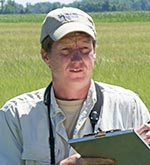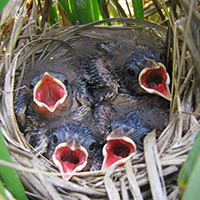



Sea level rise is the most significant issue facing coastal ecosystems and communities over the coming decades, threatening even those that can fly. Luckily for the tidal marsh birds that call the Mid-Atlantic and New England marshes and wetlands home, they have University of Delaware professor Greg Shriver and a team of researchers looking out for them.
Closeup of a
saltmarsh sparrow. »

As part of the Saltmarsh Habitat and Avian Research Program (SHARP), Shriver and his colleagues are researching tidal marsh birds from Virginia to Maine to identify and conserve areas in the region that are important to their long-term survival, and to provide a consistent platform for monitoring the health of North America’s tidal marsh bird community. The team includes researchers and students from UD, the University of Connecticut, the University of Maine and Maryland/D.C. Audubon.
“It’s a big information need for the northeast coast of North America,” says Shriver. “You’re not going to go anywhere on the planet and find more tidal marshes than you do between Georgia and Maine. This is where it happens.”
The study is looking at providing detailed conservation recommendations for six species: American black duck, Nelson’s sparrow, clapper rail, willet, saltmarsh sparrow and seaside sparrow, with a heavy focus on the latter four.
“If the marsh is gone, then these four species are gone,” Shriver warns.
The saltmarsh sparrow is of particular importance because it is endemic to the Mid-Atlantic and New England salt marshes. “The entire global population of saltmarsh sparrow is in this region. This is it,” says Shriver.
Shriver’s UD group, which includes doctoral students Whitney Wiest and Rebecca Kern, has two main research components. The first is to conduct a survey of the marshes from Virginia to New Jersey in order to estimate and predict where the marshes in certain areas are likely to move next and then help to facilitate that movement. The group is using Real Time Kinetic (RTK) GPS instruments that can give readings at sub-centimeter accuracy for the elevation of a certain location. They are then using these data to verify models of sea level rise obtained from the National Oceanic and Atmospheric Administration (NOAA).
The second component is a demographic study of the birds at a site in southern New Jersey. The birds are caught in a mist net, which is about seven-feet high and practically invisible. The birds fly into the net, and the researchers tag them. They also locate and monitor nests and estimate the annual reproductive productivity for each location. These data, combined with similar demographic surveys in sites in Connecticut and Maine, will be used to model the population viability for tidal marsh birds in the face of marsh loss caused by sea level rise.

Shriver has been studying tidal marsh birds since he initiated his dissertation work on the subject in New England in 1998. A major component of the present research project is to revisit some of the same locations he surveyed in the late 1990s to compare the populations of tidal marsh birds over time.
“So we’ll have two estimates of the number of birds at each place,” says Shriver. “And that will be the first time that anybody has attempted to show change over time for these species.”
With sea levels having risen around two millimeters per year for the past century, and with the threat of sea level rise accelerating in the future, leading to altered marsh vegetation and greater marsh loss, Shriver says it is imperative to have measures in place to help protect these birds and their habitat.
“The problem with sea level rise is you’re not going to stop it,” Shriver says, adding that the best we can do in the face of sea level rise is to “identify where the marsh is going to be and then stop anything that would impede it or help to actually facilitate marsh transgression.”
SHARP has been funded by a diversity of state wildlife agencies through regional State Wildlife Grants and the U.S. Fish and Wildlife Service within the U.S. Department of Interior. The majority of initial funding was provided by a Competitive State Wildlife Grant administered by the U.S. Fish and Wildlife Service.